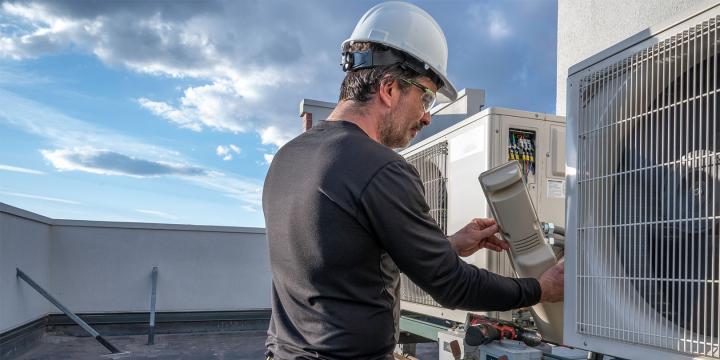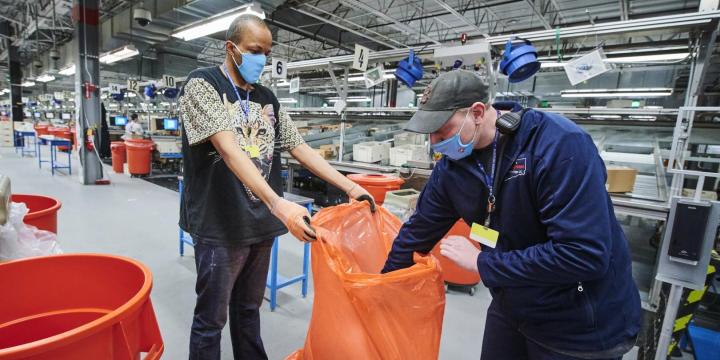Climate change is an urgent threat to people and ecosystems and presents many risks to human health. As a large, global pharmacy, healthcare and retail company, Walgreens Boots Alliance recognizes it has a responsibility and a role to play in combatting climate change. Recently, we announced a global, enterprise-wide target to reduce absolute greenhouse gas (GHG) emissions by 30 percent by 2030.
To find out what this means, we consulted our experts. David Hughes is senior director for Walgreens StoreCare and EnergyCare, programs involving maintenance and upkeep of stores as well as managing efficient and cost-effective energy systems. Sarah Bullimore is Boots UK’s sustainability manager for energy and carbon reduction. Along with their teams, they have made steady progress on GHG emissions reduction over the past few years, mostly through installing more, and updating existing, energy-efficient equipment. Learn more as they discuss the importance of this new target and how their work will help to achieve it.
Sarah Bullimore: It is critically important for companies to lead the way to combat climate change, and it was imperative for WBA to set an enterprise-wide climate target to reduce our emissions. At a global level, WBA has set a target for our GHG emissions reduction by 30 percent by the end of fiscal 2030 from a 2019 baseline. This is an absolute target, which means it refers to the total quantity of our emissions. It covers direct emissions associated with fuel combustion in boilers and vehicles, known as Scope 1 emissions, and our emissions related to the power we purchase for electricity and heating, known as Scope 2 emissions.
The target builds on the work our company has already been doing to reduce energy use and emissions across thousands of our stores, and the development of this target has been informed by science-based methodology. We also plan to review and revisit this target in two years to make sure we are doing the best we can to reduce our impact.
David Hughes: Our annual Corporate Social Responsibility (CSR) reports show yearly reductions in our emissions and the benefits of our current work, but we know we have more to do. As the Intergovernmental Panel on Climate Change states in its latest assessment report, the earth’s climate has warmed at an alarming rate. Rapid and deep reductions in CO2 and other GHG emissions need to occur in the coming decades. With that, there’s no better time to announce our public target than now. This new commitment means that WBA will do more ambitious work to reduce our environmental footprint and create positive impacts for our communities.
Hughes: We’ll continue our efforts in energy efficiency. We have been doing great work cutting our energy use through investments in more energy-efficient equipment, including lighting, refrigeration, heating, ventilation and air conditioning (HVAC) unit replacement, energy management systems and transportation. In 2020 alone, our efforts along with external factors resulted in an 8.4 percent reduction in energy usage across WBA compared with the previous year. We will continue innovating to further reduce our energy usage and explore renewable energy opportunities for our facilities.
WBA also recognizes that a holistic approach that includes partnerships is needed to meet our carbon reduction target, helping to maximize our positive impact and our influence for good. In 2020, WBA joined the United Nations Global Compact (UNGC) to align our operations and strategies with the UNGC principles and to further our action on the UN Sustainable Development Goals. We also have partnered with the Retail Industry Leadership Association, Energy Managers Association and Retail Energy Forum to further our work in finding the best solutions for energy efficiency.
Bullimore: Most of our Scope 1 and Scope 2 emissions are related to energy use for lighting and heating. Scope 1 emissions are those that come from sources controlled by the company, such as our on-site power and heating plant in Nottingham, while Scope 2 emissions result from electricity, heat and steam that we purchase and consume. WBA has more than 13,000 stores, and we recognize the scale of our electricity use to maintain operations across our retail locations, offices, data centers and distribution centers. This is why we are prioritizing our efforts in energy efficiency.
We also measure and report on some categories of indirect emissions, known as Scope 3, specifically product delivery and business travel, and these are also areas where we continue to take steps to reduce fuel consumption and cut our emissions. We do not currently measure other Scope 3 emissions such as those related to our supply chain or employee commuting. To learn more about our GHG emissions profile, you can visit our annual GHG emissions statement.
Hughes: We have concentrated on energy efficiency including lighting, refrigeration and HVAC unit replacement, this in turn has helped us reduce emissions. In fiscal 2019 and 2020, Walgreens and Boots UK invested more than $320 million toward these efforts.
Walgreens exceeded a previous target through the U.S. Department of Energy (DOE) Better Buildings Challenge, to reduce energy intensity by 20 percent across 100 million square feet of retail space by 2020 compared with 2011. We achieved this through improved HVAC and refrigeration efficiency, conversions to LED lighting and other energy efficiency programs. We also launched a new Energy Management System (EMS) program in 2020 at more than 1,200 retail locations, which enables energy-saving strategies. We estimate this initiative will achieve 16,500 metric tonnes of CO2e savings annually over the life of the initiative.
Bullimore: Across Boots UK, we reduced emissions through a number of ongoing initiatives in 2020, such as installing doors on refrigerated cabinets in stores, replacing lighting and optimizing heating and cooling systems. Almost all of the energy that Boots UK and Boots Ireland purchase from the grid is certified renewable, generated by solar, wind or hydro power.
Boots UK also supports the British Retail Consortium's (BRC) Retail Climate Action Roadmap with targets to be net zero by 2040 across Scopes 1, 2 and 3 (Scope 2 by 2035 and Scope 1 by 2030). We are also one of the development funders of BRC’s work to drive lower emissions in shops, distribution centers and logistics operations, cutting emissions in supply chains and guiding customers toward dramatically lowering their own carbon footprints. Boots has also committed to Business in the Community Ireland’s Low Carbon Pledge, which includes reducing Scope 1 and 2 emissions, as well as playing its part in reducing Scope 3 emissions across its supply chain.
We believe our continued energy efficiency efforts and our EMS program will contribute to the WBA climate commitment. At the same time, we understand this is the first step on our journey and we have much more to do.
Hughes: Walgreens is continuously working on ways to make its fleet more fuel efficient. Last year, we introduced wheel covers on 645 tractors and 1,680 trailers that provide greater aerodynamics and are anticipated to result in a 1- to 2-percent improvement in overall fuel efficiency.
We are also supporting our customers who have electric vehicles. Walgreens has hundreds of electric vehicle charging stations at stores around the U.S.
Bullimore: Boots UK also revisited its route planning with a goal to permanently reduce daily stops from 800 stores to 250 stores, resulting in a decline of 600 metric tonnes in CO2e emissions. Boots UK 2020 emissions from product delivery decreased by more than 25 percent from the previous year.
Hughes: We will be keeping our customers, employees and stakeholders informed on our progress toward meeting our target through our website, our annual reporting on our environmental impact and our annual climate change questionnaire submission to CDP, a nonprofit organization for company disclosures on this topic. We will continue to evaluate opportunities to expand upon this commitment as we look toward a low-carbon future.
Bullimore: Absolutely. We’re aware that we must continue to consider other areas of influence WBA can have around purchased goods, waste streams, associated product delivery distribution and end of product life.
Hughes: We have numerous exciting programs where we are working to reduce waste, increase recycling, divert waste from landfill and sustainable packaging innovation in our owned brand products.



